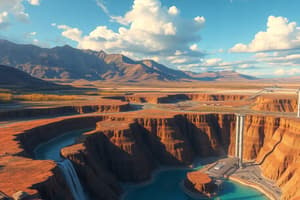Podcast
Questions and Answers
Flash steam power plants use cold water to produce electricity.
Flash steam power plants use cold water to produce electricity.
False (B)
Binary cycle power plants are an example of direct heating systems.
Binary cycle power plants are an example of direct heating systems.
False (B)
Wet steam contains pressurized water at a temperature higher than 100°C.
Wet steam contains pressurized water at a temperature higher than 100°C.
True (A)
Enhanced Geothermal Systems involve the circulation of water through naturally occurring fractures and porous rock formations.
Enhanced Geothermal Systems involve the circulation of water through naturally occurring fractures and porous rock formations.
Geopressured resources have a reservoir fluid pressure that is lower than hydrostatic pressure.
Geopressured resources have a reservoir fluid pressure that is lower than hydrostatic pressure.
Low-Temperature Geothermal Resources fall under temperature-based classification systems.
Low-Temperature Geothermal Resources fall under temperature-based classification systems.
Flashcards are hidden until you start studying
Study Notes
Introduction to Geothermal Engineering
- Renewable energy is sustainable and clean, obtained from inexhaustible sources, and non-polluting, with many forms not emitting greenhouse gases or toxic waste.
- Geothermal energy is energy extracted from the heat in the earth, used for cooking, bathing, space heating, electrical power generation, and other uses.
Why Use Renewable Energy?
- Renewable energy mitigates climate change and fosters sustainable development.
- The Clean Development Mechanism provides carbon credits, and the Renewable Energy law gives incentives for Renewable Energy sources to make RE projects attractive and viable.
Why Use Renewable Energy in the Philippines?
- Renewable energy provides energy security, supports the government's goals of energy self-sufficiency and sustainability, addresses environmental concerns, and widens carbon trading opportunities for the country.
Geothermal Energy in the Philippines
- The Philippines has a total installed capacity of 1916 MW geothermal energy.
- The Philippine Government aims to increase its renewable energy capacity to an estimated 15,304 MW by 2030, comprising 1495 MW for geothermal capacity.
Geothermal Resources
- Geothermal resources are reservoirs of hot water that exist or are human-made at varying temperatures and depths below the earth's surface.
- Geothermal resources are a natural source of heat trapped beneath the earth's surface, originating from the planet's core and radioactive decay in the mantle.
Classifications of Geothermal Resources
- Hydrothermal resources are the most common and widely used type of geothermal energy, developed using existing technologies and not requiring creation of human-made reservoirs.
- Hydrothermal resources can be divided into two types:
- Vapor Dominated Systems: 150 to 250°C, superheated steam is produced, and used for electric generation.
- Water Dominated Systems: 50°C to 100°C, hot water is used for thermal applications, and wet steam is used for power generation.
Enhanced Geothermal Systems (EGS)
- EGS are hot dry rock systems that involve creating and enhancing fractures in hot dry rock formations that have low natural permeability.
- Water is injected into these artificially created fractures and gets heated by contact with the hot rock.
Geopressured Resources
- Geopressured resources are reservoir fluids with pressure that significantly exceeds hydrostatic pressure and may even approach overburden pressure.
- Geopressured resources are a type of geothermal resource that is used for electricity generation and direct heating applications.
Studying That Suits You
Use AI to generate personalized quizzes and flashcards to suit your learning preferences.





